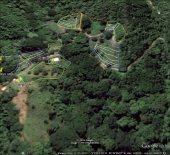




There is nothing so lovely as a pasture field with a creek running through it, but you will pay for it a thousand times over. If you have a pasture, you have livestock grazing there, and so where the creek enters and exits the pasture, you must have fencing decidedly different from what you have on dry land to keep your animals from wading out of the pasture and to keep your neighbor’s animals from wading in. We’ve always called them floodgates. So far as I know, no one has yet invented one that really works without spending a fortune. I was certain, when confronted with the necessity of floodgates, that I could design one that would work without my constant attention. A hundred or so floodgates later, I admitted defeat.
My project thread
Agriculture collects solar energy two-dimensionally; but silviculture collects it three dimensionally.








Success has a Thousand Fathers , Failure is an Orphan
LOOK AT THE " SIMILAR THREADS " BELOW !




"You must be the change you want to see in the world." "First they ignore you, then they laugh at you, then they fight you, then you win." --Mahatma Gandhi
"Preach the Gospel always, and if necessary, use words." --Francis of Assisi.
"Family farms work when the whole family works the farm." -- Adam Klaus




james Apodaca wrote:...i dont think I've ever paid attention to how the rancher traverses the canal with his fencing.
My project thread
Agriculture collects solar energy two-dimensionally; but silviculture collects it three dimensionally.




allen lumley wrote:The 1st Question to askis why does the fence line Have to go there ?
My project thread
Agriculture collects solar energy two-dimensionally; but silviculture collects it three dimensionally.




R Scott wrote:
There are two basic solutions around here. Either a super stout welded pipe structure or a breakaway fence, built with a "fuse" to let go before the rest of the wire breaks-kind of like the old wire gates before people got lazy and put hinged tube gates everywhere.
My project thread
Agriculture collects solar energy two-dimensionally; but silviculture collects it three dimensionally.




 1
1








Joe Braxton wrote:Cj, is it possible to enlarge the basin behind the dam?
My project thread
Agriculture collects solar energy two-dimensionally; but silviculture collects it three dimensionally.




![Filename: Screen-Shot-2015-01-02-at-11.15.52-AM.png
Description: Breakaway example from Joe's link [Thumbnail for Screen-Shot-2015-01-02-at-11.15.52-AM.png]](/t/42788/a/24269/Screen-Shot-2015-01-02-at-11.15.52-AM.png)
My project thread
Agriculture collects solar energy two-dimensionally; but silviculture collects it three dimensionally.




My project thread
Agriculture collects solar energy two-dimensionally; but silviculture collects it three dimensionally.




Joe Braxton wrote:I believe this is what R Scott was talking about..
Can't seem to put an image in so....
http://www.albemarle.org/upload/images/forms_center/departments/Community_Development/forms/Engineering_and_WPO_Forms/Floodplain_Fencing_info_sheet.pdf
"You must be the change you want to see in the world." "First they ignore you, then they laugh at you, then they fight you, then you win." --Mahatma Gandhi
"Preach the Gospel always, and if necessary, use words." --Francis of Assisi.
"Family farms work when the whole family works the farm." -- Adam Klaus

|
Do Re Mi Fa So La Tiny Ad
The new permaculture playing cards kickstarter is now live!
https://www.kickstarter.com/projects/paulwheaton/garden-cards
|






